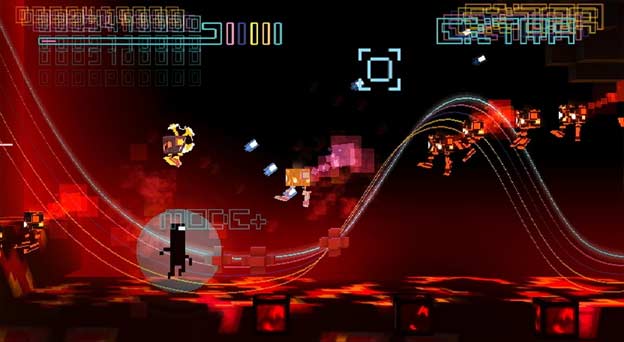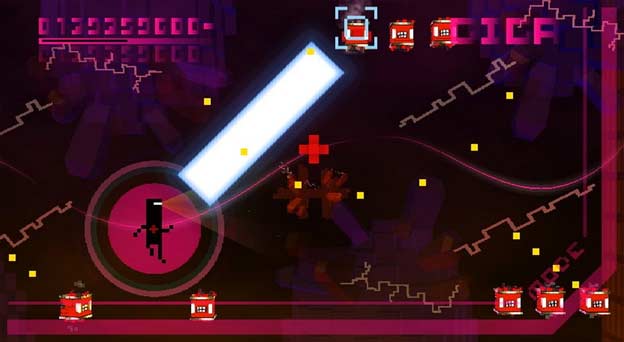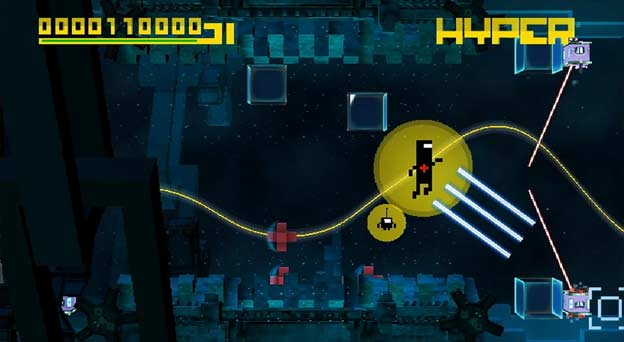Commander Video has come a long way. Though his initial appearance as an oblong pixilated figure that leaves a rainbow trail wherever he goes hasn’t changed much from Bit.Trip’s initial offering, Bit.Trip Beat, the evolutionary journey undertaken by the hero of Gaijin’s retro-chic indie series has undergone quite a few changes since its inception. To date, the Commander’s journey has taken him through abstractions of classic arcade games, including Pong and old-school tube shooters; with each passing game, the series mascot progressed further and further towards prominence, becoming more of a character and less of a strange entity interspersed throughout a series of seemingly otherwise unrelated game designs.

If you look at the first four games in the Bit.Trip series, this kind of evolutionary journey makes sense, given the arguable slice of “gaming history” each title has presented. The idea of progression has also been a staple of gameplay in the Bit.Trip series, with a player’s success or failure resulting in a sense of aural progression or regression as heard by each game’s chiptune-inspired soundtrack. With the release of Bit.Trip Runner, an on-rails platformer where the player actually controlled Commander Video for the first time, it seemed as though Gaijin’s tour of gaming evolution may have been complete. What could they possibly do with the last two planned games in the series?
With the release of Bit.Trip Fate, I think it’s safe to say that Bit.Trip has decided to simply do its own thing. Whether or not the evolutionary themse of the first four games was entirely intentional or not, Fate veers off in a wildly different direction. All the core components of the Bit.Trip experience are there: the pulsing, gradual electronic soundtrack, the emphasis on rhythmic design (as in what you do on-screen corresponds with how a level’s music unfolds), and the challenging difficulty level. But the game is, as odd as it sounds, a 2D on-rails shooter. Now, when I say “on-rails shooter” I don’t mean that it’s like any classic arcade action title with scrolling level design. I mean that Commander Video is literally tethered to a linear path that runs through each level with all its own peaks, valleys, hills, and dips. The game plays more or less like a horizontal shooter like Gradius or R-Type yes, there are plenty of shades of bullet hell to be found here except you can only move left and right (or where the line permits, up and down) rather than anywhere on-screen. The Bit.Trip series has always prided itself on its indie cred, and it certainly wears it on its sleeve here. The idea of a truly on-rails shooter isn’t one you come across every day, after all.
The idea may seem a little obtuse at first. Using the Nunchuck, you can move Commander Video around on the line he is forced to travel, while you point and fire an on-screen targeting reticle with the Wiimote (one could make an argument that since Fate is the first Bit.Trip to use a control scheme involving more than just the Wiimote, there may still be an evolutionary thread continuing here). Thankfully, the setup quickly becomes second nature, and as you get deeper into the game you’re often forced to pay attention to multiple gameplay elements at once. Once you figure out that it’s only the plus-sign in Commander Video’s chest that’s vulnerable to enemy fire, the rest of the game’s design naturally and easily falls into place if you’ve played any other horizontal shooters. Though you’re tied to whatever line patterns Gaijin deemed appropriate per level, you’re free (and will need to) move around on the line in order to avoid incoming projectiles from enemies. As with any good shooter, this will be easier said than done, since not only will the numbers of enemies increase and their patterns diversify, but in the tougher, latter stages of the game you’ll often be forced to have a certain number of power-ups in use in order to bypass enemy patterns that are tricky if not impossible to see through without getting hit.

Given the series’ reputation for difficulty, of course this is exactly what is most crucial in Fate. In the initial iterations of the series, getting hit mostly just resulted in a loss of your combo score and maybe a hit to the game’s trippy synaesthetic experience (though its avoidance became the maddening crux of the gameplay in Runner, which sadistically sent you back to the beginning of a level if even a single mortal mistake was committed). Keeping track of your score here is vitally linked to success here, though. The more enemies you take out, the more power-ups you can collect, which in turn dictates how powerful your shots are (again, pretty standard shooter design-fare). While it’s possible at least in some cases to make it all the way to the end of a level without weapons upgrades, it would be a fool’s errand to try. Naturally, keeping from getting hit in increasingly difficult situations can be taxing, meaning you’ll have to replay stages over and over again to fully grasp all the intricacies of pattern memorization and enemy and power-up placements. That also doesn’t account for the boss encounters; like previous Bit.Trip titles, you have to play the whole level again if you screw up at the boss. And given the aggro bullet-hell attack patterns that some of these guys have, that means you’re probably going to die a whole lot. Not only will it take you a while to figure out exactly how to dodge their projectiles, but these screen-filling behemoths also usually take at least five minutes of concentrated fire that’s when you can attack their vulnerable spot before succumbing. So even the slightest mistake can lead to a psychological screw-up that will set you back to the beginning of the level. Thankfully this doesn’t reach the fever pitch of insane expectation required to best some of the later stages in Runner, but rest assured, Fate isn’t exactly going to go easy on you. Unfortunately, the deck is generally stacked against you here; not even the temporary additional upgrades to your weapons (named after other indie darling mascots like Super Meat Boy) are available for use at the end of a stage.

With the bizarre turn that Fate makes for the series, I’m interested to see where Commander Video will ultimately end up in the last planned Bit.Trip game. Now that the series has a firmly established identity, Fate seems to take Bit.Trip in an interesting narrative direction, with the idea of fate both being literally tied to the gameplay as well as the progression into a seeming meta-hell the Commander is forced to descend into. The narrative style is definitely unconventional up until Fate it’s been all but indecipherable but its presence only makes me that much more eager to find out however the journey will end. In whatever case, I’m sure it won’t be easy.
RATING OUT OF 5 RATING DESCRIPTION 4.3 Graphics
Like Runner, Fate takes a simple style and amplifies it to more than the sum of its parts. 4.0 Control
Sliding along the fixed-rail while using the Wiimote to point and shoot targets is smooth and easy. 4.5 Music / Sound FX / Voice Acting
Music is vastly important to the Bit.Trip experience, and thankfully Fate doesn’t disappoint. 4.3
Play Value
Fate is another solid entry in the series just watch out for those insane boss battles.
4.3 Overall Rating – Great
Not an average. See Rating legend above for a final score breakdown.
Game Features:
